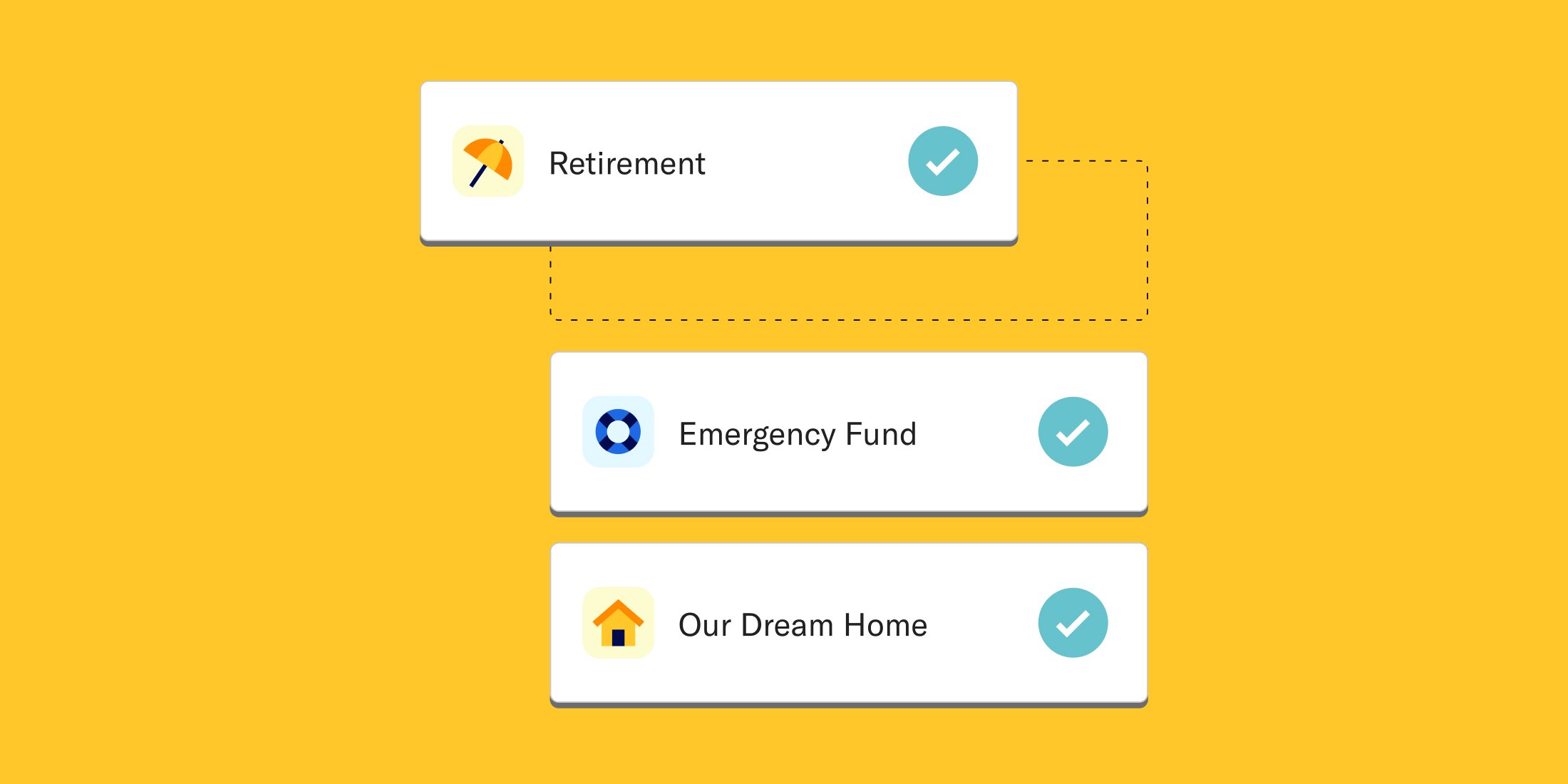App

Featured articles
-
![]()
Betterment's Recommended Allocation Methodology
Betterment helps you meet your goals by providing allocation advice. Our allocation ...
Betterment's Recommended Allocation Methodology Betterment helps you meet your goals by providing allocation advice. Our allocation methodology and the assumptions behind it are worth exploring. When you sign up with Betterment, you can set up investment goals you wish to save towards. You can set up countless investment goals. While creating a new investment goal, we will ask you for the anticipated time horizon of that goal, and to select one of the following goal types. Major Purchase Education Retirement Retirement Income General Investing Safety Net Betterment also allows users to create cash goals through the Cash Reserve offering, and crypto goals through the Betterment Crypto Investing offering. These goal types are outside the scope of this allocation advice methodology. For all investing goals (except for Safety Nets) the anticipated time horizon and the goal type you select inform Betterment when you plan to use the money, and how you plan to withdraw the funds (i.e. full immediate liquidation for a major purchase, or partial periodic liquidations for retirement). Safety Nets, by definition, do not have an anticipated time horizon (when you set up your goal, Betterment will assume a time horizon for Safety Nets to help inform saving and deposit advice, but you can edit this, and it does not impact our recommended investment allocation). This is because we cannot predict when an unexpected emergency expense will arise, or how much it will cost. For all goals (except for Safety Nets) Betterment will recommend an investment allocation based on the time horizon and goal type you select. Betterment develops the recommended investment allocation by projecting a range of market outcomes and averaging the best-performing risk level across the 5th-50th percentiles. For Safety Nets, Betterment’s recommended investment allocation is formed by determining the safest allocation that seeks to match or just beat inflation. Below are the ranges of recommended investment allocations for each goal type. Goal Type Most Aggressive Recommended Allocation Most Conservative Recommended Allocation Major Purchase 90% stocks (33+ years) 0% stocks (time horizon reached) Education 90% stocks (33+ years) 0% stocks (time horizon reached) Retirement 90% stocks (20+ years until retirement age) 56% stocks (retirement age reached) Retirement Income 56% stocks (24+ years remaining life expectancy) 30% stocks (9 years or less remaining life expectancy) General Investing 90% stocks (20+ years) 56% stocks (time horizon reached) Safety Net Safest allocation that seeks to match or just beat inflation Safest allocation that seeks to match or just beat inflation As you can see from the table above, in general, the longer a goal’s time horizon, the more aggressive Betterment’s recommended allocation. And the shorter a goal’s time horizon, the more conservative Betterment’s recommended allocation. This results in what we call a “glidepath” which is how our recommended allocation for a given goal type adjusts over time. Below are the full glidepaths when applicable to the goal types Betterment offers. Major Purchase/Education Goals Retirement/Retirement Income Goals Figure above shows a hypothetical example of a client who lives until they’re 90 years old. It does not represent actual client performance and is not indicative of future results. Actual results may vary based on a variety of factors, including but not limited to client changes inside the account and market fluctuation. General Investing Goals Betterment offers an “auto-adjust” feature that will automatically adjust your goal’s allocation to control risk for applicable goal types, becoming more conservative as you near the end of your goals’ investing timeline. We make incremental changes to your risk level, creating a smooth glidepath. Since Betterment adjusts the recommended allocation and portfolio weights of the glidepath based on your specific goals and time horizons, you’ll notice that “Major Purchase” goals take a more conservative path compared to a Retirement or General Investing glidepath. It takes a near zero risk for very short time horizons because we expect you to fully liquidate your investment at the intended date. With Retirement goals, we expect you to take distributions over time so we will recommend remaining at a higher risk allocation even as you reach the target date. Auto-adjust is available in investing goals with an associated time horizon (excluding Safety Net goals and the BlackRock Target Income portfolio) for the Betterment Core portfolio, SRI portfolios, Innovation Technology portfolio, and Goldman Sachs Smart Beta portfolio. If you would like Betterment to automatically adjust your investments according to these glidepaths, you have the option to enable Betterment’s auto-adjust feature when you accept Betterment’s recommended allocation. This feature uses cash flow rebalancing and sell/buy rebalancing to help keep your goal’s allocation inline with our recommended allocation. Adjusting for Risk Tolerance The above investment allocation recommendations and glidepaths are based on what we call “risk capacity” or the extent to which a client’s goal can sustain a financial setback based on its anticipated time horizon and liquidation strategy. Clients have the option to agree with this recommendation or to deviate from it. Betterment uses an interactive slider that allows clients to toggle between different investment allocations (how much is allocated to stocks versus bonds) until they find the allocation that has the expected range of growth outcomes they are willing to experience for that goal given their tolerance for risk. Betterment’s slider contains 5 categories of risk tolerance: Very Conservative: This risk setting is associated with an allocation that is more than 7 percentage points below our recommended allocation to stocks. That’s ok, as long as you’re aware that you may sacrifice potential returns in order to limit your possibility of experiencing losses. You may need to save more in order to reach your goals. This setting is appropriate for those who have a lower tolerance for risk. Conservative: This risk setting is associated with an allocation that is between 4-7 percentage points below our recommended allocation to stocks. That’s ok, as long as you’re aware that you may sacrifice potential returns in order to limit your possibility of experiencing losses. You may need to save more inorder to reach your goals. This setting is appropriate for those who have a lower tolerance for risk. Moderate: This risk setting is associated with an allocation that is within 3 percentage points of our recommended allocation to stocks. Aggressive: This risk setting is associated with an allocation that is between 4-7 percentage points above our recommended allocation to stocks. This gives the benefit of potentially higher returns in the long-term but exposes you to higher potential losses in the short-term. This setting is appropriate for those who have a higher tolerance for risk. Very Aggressive: This risk setting is associated with an allocation that is more than 7 percentage points above our recommended allocation to stocks. This gives the benefit of potentially higher returns in the long-term but exposes you to higher potential losses in the short-term. This setting is appropriate for those who have a higher tolerance for risk. -
![]()
3 Low-Risk Ways To Earn Interest
Earning interest usually means taking on risk. But with bonds and cash accounts—and ...
3 Low-Risk Ways To Earn Interest Earning interest usually means taking on risk. But with bonds and cash accounts—and investing’s potential for compound interest—you can minimize that risk. In 1 minute When you don’t have much time to reach your goal, you can’t afford to make a risky investment. Thankfully, you can earn interest without putting everything on the line. Here’s how. Bonds Bonds are one of the most common types of financial assets. They represent loans, which a business or the government uses to pay for projects and other costs. Just as you pay interest when you take out a loan, bonds pay investors interest. You’ll typically see lower returns than you might with stocks, but the risk is generally lower, too. Cash accounts Cash accounts are similar to traditional savings accounts, only they are typically designed to earn more interest (and may come with more restrictions). These are great when you need your money to be readily available to you, but still want to earn some interest. And to top it off, many cash accounts are offered at or through banks so your deposits are FDIC insured, so there’s minimal risk. Compound interest In addition to bonds and cash accounts, there’s one more way to earn interest—investing and earning compound interest, which is the interest generated from previous rounds of interest itself. That’s right. As you accrue interest on your underlying investing funds, that interest makes money and that money in turn makes more money. The longer and more frequently your interest compounds, the more you can earn. In 5 minutes Want to earn interest? You usually have to take some risk which means you could lose some money. Financial assets can gain or lose value over time. And investments that have the potential to earn greater interest often come with the risk of greater losses. But there are ways to lower your risk. If you have a short-term financial goal or you’re just cautious, you can still earn interest. It might not be much, but it will be more than you’d get keeping cash under your mattress (don’t do that). In this guide, we’ll look at: Bonds Cash accounts Compound interest Bonds Bonds are basically loans. Companies and governments use loans to fund their operations or special projects. A bond lets investors help fund (and reap the financial benefits of) these loans. They’re known as a “fixed income” asset because your investment earns interest based on a schedule and matures on a specific date. Bonds are generally lower-risk investments than stocks. The main risks associated with bonds are that interest rates can change, and companies can go bankrupt. Still, these are typically fairly stable investments (depending on the type of bond and credit quality of the issuer), making them a good option for short-term goals. With municipal bonds, you can earn tax-free interest. These bonds fund government projects, and in return for the favor, the government doesn’t tax them. Invest in your own state, and you could avoid federal and state taxes. Even when your goal is years away, including bonds in your investment portfolio can be a smart way to lower your risk and diversify your investments. Cash accounts Cash accounts seek to earn more interest than a standard savings or checking account, and they’re federally insured by the FDIC or NCUA. (This is usually the case but depends on the institution housing your deposits (i.e., banks or credit unions). Check to make sure your account is insured before depositing any money.) In most cases, there’s little risk of losing your principal. Your interest is based on the annual percentage yield (APY) promised by the bank or financial institution you open the account with. One of the great perks of a cash account is that it’s highly liquid—so you can use your money when you want. It won’t earn as much interest as an investment, but it won’t be as tied up when you need it. For short-term financial goals, a cash account works just fine. The key is to choose an account that meets your needs. Pay attention to things like minimum deposits, transaction limits, fees, and compound frequency (that’s often how it accrues interest). These differences affect how fast your savings will actually grow and how freely you can use it. Compound interest Compound interest refers to two things: The interest your investments or savings earn The interest your interest earns It’s your money making more money. If you want to build wealth for the long-term, investing and allowing your interest to compound is one of the smartest moves you can make. The sooner you invest and put your money to work, the more opportunity your money has to earn compound interest. Compound interest starts small, but can grow exponentially. Your investment has the potential to grow faster because your interest starts earning interest, too. If you start young, you have a huge advantage: time is on your side! While compound interest accrues with minimal risk, investing in the market involves varying levels of risk. -
![]()
How Betterment’s Tech Helps You Manage Your Money
Our human experts harness the power of technology to help you reach your financial goals. ...
How Betterment’s Tech Helps You Manage Your Money Our human experts harness the power of technology to help you reach your financial goals. Here’s how. When you’re trying to make the most of your money and plan for the future, financial advisors are really helpful. But there are some things humans simply can’t do as well as algorithms. And investing is an area where automation and digital tools can help improve your outcomes and make advanced strategies more accessible. Here at Betterment, we’re all about using technology—with human experts at the helm—to manage your money smarter and help you meet your financial goals. In this guide, we’ll Explore the concept of a “robo-advisor” Talk about Betterment’s human approach to technology Share how we help your investing avoid idle cash Share how our tech helps you plan for the future Show how you can access additional advice A quick primer on the rise of robo-advisors There’s a word for the investment firms who first used technology in new and exciting ways in the service of everyday investors: robo-advisors. By letting their human experts and technology do what each does best, robo-advisors provide some key benefits: Optimized time.Robo-advisors use algorithms and automation to do all the busy work, optimizing your investments faster than a human can. The result: you spend less time managing your finances and more time enjoying your life. Lower fees.Because of their efficiency, robo-advisors cost less to operate, which translates to savings for you. While the specific fees vary from one robo-advisor to the next, they all tend to be a fraction of what it costs to work with a traditional investment manager. Lower barriers to entry.Almost anyone with Internet access can use a robo-advisor. No special expertise required. And you don’t need a big minimum investment to get started. Personalized recommendations.Robo-advisors help you focus on your specific reasons for saving, adjusting your risk based on your timeline and target amount. Robo-advisors do the heavy lifting behind the scenes, managing all the data analysis and adapting investment expertise to fit your circumstances. All you need to do is fill in the gaps with details about your financial goals. If you have the time to research, implement and routinely manage your own investment strategy, you still can, but you don’t have to. That’s the beauty of working with a robo-advisor. The experience is as hands-on as you want it to be. Or you can relax in the knowledge your investments are in good hands, so you can simply live your life. How we combine human expertise with technology Automation is what we’re known for. But our team of financial experts is our secret sauce. They research, prototype, and implement all the advice and activity that you see in your account. Our algorithms and tools are built on the expertise of traders, quantitative researchers, tax experts, CFP® professionals, behavioral scientists, and more. Then we use technology to help accurately and consistently execute your investment strategy. Our automated processes manage your portfolio, monitoring for opportunities to rebalance and then rebalancing once accounts cross a $50 threshold if it drifts too far from your target allocation, and executing any tax strategies you’ve enabled. Technology also lets us put all of your deposits to work and avoid idle cash. Keep reading for more on that. How we automate to help you avoid the cost of idle cash Cash is an essential part of our financial lives. You can’t pay for this week’s groceries with stock, after all. And it may reassure you to keep your emergency fund in cash, although we’d politely point out you have other options to consider there. But there’s little benefit to letting cash sit idle in your investing accounts. That’s because it’s missing out on potential market returns, while at the same time losing value in times of inflation, which is most times. This double whammy can mean serious setbacks in achieving long-term investing success. That’s why we use technology to invest every penny of yours put toward a portfolio of ETFs. Here’s how: We automatically reinvest the dividends your investments pay out. Dividends are the cash earnings companies regularly distribute to shareholders. We purchase fractions of shares on your behalf, meaning if you deposit enough money to purchase 2 ⅔ shares of an ETF, that’s exactly how many shares you’ll get. For years, many investing firms would round up or down to the nearest whole share and leave the remaining cash idle in your account. Speaking of other brokerage firms, you may still have investing accounts with some. So what’s an investor to do in that case? Well, if you connect these external accounts to Betterment, we can highlight each of your external portfolio’s total idle cash. We hope this information is a starting point that helps you decide whether it’s worth it to transfer that money to a different firm. How we help you plan for the future Nobody knows the future. And that makes financial planning tough. Your situation can change at any time. And we can’t predict how external factors like markets, inflation, or tax rates may shift. But that doesn’t mean you should give up and stop planning. Our tools and advice can help you see how various changes could affect your goals. We show you a range of potential outcomes so you can make more informed decisions. We estimate how market performance may affect your investments Financial experts use many different methods to estimate future returns of a portfolio. Many financial calculators simply assume a constant average return. This is usually based on historical returns of a benchmark, like the S&P 500 index. But there are several problems with assumptions like this: You aren’t usually invested exactly like the benchmark. Different mixes of stocks and bonds or other assets in your portfolio will result in different ranges of outcomes. You probably have multiple financial goals, each with their own time horizons. The different risk allocations for each goal shouldn’t have the same returns assumption. Assumptions based on a historical estimate are sensitive to the time horizon used to calculate them. At Betterment, we’ve made three improvements to this method to make more accurate estimates: We use a return estimate for the specific portfolio you select for each goal. For example, our estimate for a 90% stock portfolio is different from our estimate for an 85% stock portfolio. Each is based on the asset classes you actually hold. We factor market volatility into our estimates. This produces the range of returns you see on the goal forecaster. For example, our savings estimates assume a somewhat conservative 40th percentile outcome (60% chance of success) rather than the simple average (50% chance of success). We assume that a risk-free component of expected returns can vary over time. When interest rates rise (or fall), so should your expected returns. We consider the impact of tax rates We may not be able to predict future tax rates, but we can be pretty sure that certain incomes and account types will be subject to some taxes. This becomes especially relevant in retirement planning, where taxes affect which account types are most valuable to you (such as a traditional IRA or Roth IRA) and your current and future income. Here’s how we estimate tax rates for your accounts: We use the latest tax data available. We always update federal tax information on January 1. State tax rate information is harder to come by, but we update it as soon as possible. Historically, that has been six to twelve months into the year. Tax bracket ranges are typically adjusted for inflation, so we assume that inflation by itself will not cause major changes to your tax rate. Your income will likely be different in the future, and that will affect your tax rate. So we use income increases due to inflation and typical salary growth to estimate what your future tax rate might be. We allow tax deduction and dependent overrides, which can affect your personal rate. We plan ahead for inflation We don’t know how inflation will change, but we can reference known historical ranges, as well as targets set by fiscal policy. The most important thing is to factor in some inflation—especially for long-term goals like retirement—because we know it won’t be zero. We currently assume a 2% inflation rate in our retirement planning advice and in our safe withdrawal advice, which is what the Fed currently targets. Getting additional advice At Betterment, we automate what we can, and leave the rest to humans. Machines are ideal for rule-based decisions, calculations at scale, and data-aggregation. But people are usually better at complex decisions, abstract thoughts, and flexibility in logic and inputs. Human advisors are much better at behavioral coaching, building advice models, and dealing with complex financial situations. So we complement our automated advice with access to our financial planning experts through advice packages or our Premium plan, which offers unlimited calls and emails with our team of CFP® professionals. Whether you need a one-time consultation or ongoing support, you can always discuss your unique financial situations with one of our licensed financial professionals. Managing your money with Betterment Our mission is to empower you to make the most of your money, so you can live better. Sometimes the best way to do that is with human creativity and critical thought. Sometimes it’s with machine automation and precision. Usually, it takes a healthy dose of both.
Considering a major transfer? Get one-on-one help with one of our experts. Explore our licensed concierge
All App articles
-
![]()
How We Can Do Better at Building Black Wealth
How We Can Do Better at Building Black Wealth In honor of Black History Month, we reflect on the past, present and future state of Black wealth. We at Betterment dedicate our time and energy with the goal to make people’s lives better through investing. So when deciding how best to join the chorus of Black empowerment that builds each February during Black History Month, we decided to focus on generational wealth. At the end of the day, we believe that wealth-building is one of the most powerful tools to live a better life and lead a path for generations to come. The uncomfortable truth behind the racial wealth gap We can’t fully appreciate the importance of creating generational wealth for Black people without acknowledging our collective past and examining where it has left us. It’s no secret that rising out of slavery did not create equality for Black Americans in 1865. Over a century and a half later, there are still enormous wealth disparities between Black and non-Black households. According to the 2019 Survey of Consumer Finances, the average net worth of a White family is over 7x than that of a Black family. Many factors have contributed to this gap–and continue to persist–including years of housing discrimination, credit inequality, mass incarceration, inaccessible healthcare and education, and lower paying jobs. The domino effect of these factors leaves Black families with little to inherit and often less to pass on. So now what? The racial wealth gap is clearly not just a Black problem, nor can it be solved by individual actions alone. Organizations like the National Advisory Council on Eliminating the Black-White Wealth Gap are at the forefront of developing proposals to address the issue systemically. Ideas range from job creation to baby bonds to reparations. Ultimately, we all have a part in building strong Black financial futures. Here at Betterment, we’re committed to supporting individuals through our investing products and our voices. In that spirit, we’ve gathered resources in the section below to help chip away at the gap through personal finance decisions. Personal steps to building Black wealth Despite systemic barriers, there are still tangible strategies that Black Americans can apply to help boost their wealth: Make the most of your savings Before parking your cash in a standard savings account (or worse…your mattress), consider a Cash Reserve account. Think of it as an alternative option with none of the common drawbacks like transfer limits, minimums, and fees. Create multiple streams of income You can reward yourself for the hard work at your day job by letting your money work for you. Passive income is earned through sources like interest and dividends from stocks with minimal effort. Automated investing can make earning passive income even simpler. Align your investments to your goals Whether you’re an expert or completely new to investing, a goal-based approach can help you personalize your financial plan. Once you’ve thought about your short-term and long-term needs, you can set an investment strategy that aligns with your values and risk tolerance. Here are articles written by our own Bryan Stiger, CFP®, that can also help you get your financial house in order: How to Build an Emergency Fund An Investor’s Guide to Diversification Setting and Prioritizing Your Financial Goals How to support or invest in organizations working to improve Black lives Centuries of racism, institutional discrimination and lack of wealth building opportunities still impact the Black community today. Here are five organizations you can donate to today who are working to address these social and economic gaps: Center for Black Equity: Improving the lives of Black LGBTQ+ Black people globally Black Girls Code: Fighting to establish equal representation in the tech sector Black Organizing for Leadership and Dignity (BOLD): Training Black organizers in the US National Fair Housing Alliance: Working to eliminate housing discrimination Equal Justice Initiative: Fighting to end mass incarceration and racial inequality If you’re a Betterment customer, you have two additional avenues for empowering like-minded organizations: Donate eligible shares to any of our partner charities through our Charitable Giving feature. Here are three of those partner charities working to improve Black lives: NAACP Empowerment Programs Envision Freedom Fund American Civil Liberties Union (ACLU) Invest in companies actively working toward minority empowerment through our Socially Responsible Investing portfolios. What does Black wealth look like? We recognize that wealth is different for everyone. For Black communities, we believe wealth looks like empowerment, equity and the means to pass something meaningful from one generation to the next. We hope that you’ll join us this month to celebrate Black excellence and get involved in building Black wealth. -
![]()
How Much of Your Portfolio Should be in Crypto?
How Much of Your Portfolio Should be in Crypto? Our golden rule to investing in crypto. How much to invest in crypto is a personal question all investors have to answer. We’ll get straight to our recommendation. We call it our 5% golden rule: At Betterment, we recommend investing 5% or less of your investable assets (your investable cash, stocks, bonds, mutual funds, exchange-traded funds, etc.) in crypto. Assuming you are a long-term investor, a simple way to think about this is to ask yourself how confident you are that the crypto industry will continue to grow over time. Then decide how much you want to invest into a diversified portfolio based on that, no more than 5% of your investable assets. Where does the 5% golden rule come from? Using some math with fancy terms like the Black-Litterman model, our investing experts can calculate our maximum recommended crypto allocation. To get to our recommended allocation, the model takes into consideration our analyst’s answers to two important questions: How much, by percent, will crypto outperform stocks per year? In terms of probability, how confident are you that crypto will outperform stocks? Answers to both of the questions above exist on a spectrum, meaning that individuals may have different answers to the two questions. By plugging in the answers to those two questions into the Black-Litterman model, our experts recommend no more than 5% if you have high confidence that crypto will significantly outperform stocks. Many individuals may not be as confident in crypto outperforming stocks. In this case, we would recommend allocating less than 5% to match your comfort level. Allocation then diversification. Once you settle on your preferred crypto allocation of 5% or less, remember to consider diversification. All of our Crypto Investing portfolios are designed to offer broad diversification across many crypto assets. -
![]()
Making Sense of Crypto Volatility
Making Sense of Crypto Volatility Crypto is a volatile asset class. But there are things you can do to prepare for likely losses that accompany potential gains. We’ll jump straight to the point: Crypto is definitely a volatile asset class, meaning it can have large positive and negative returns. But there are things you can do to prepare for likely losses that accompany potential gains. Your secret power: Being ready for volatility There is no sugar-coating volatility in crypto, but understanding it can help set you up for long-term success. As an investor, having a plan for how you will respond to volatility ahead of time (and sticking to it) can be your secret power. When the market falls and everyone else is panic selling, you’ll know what to do. Let’s cover the basics of volatility in crypto: Volatility refers to how much crypto prices change over time. Generally, the larger the price changes, the more risky an investment tends to be, and the greater chances of both gains and losses. Crypto has been very volatile in its short life, with prices climbing and falling regularly. For example, since 2021, the price of Bitcoin has bounced around with peaks near $70,000 and lows under $20,000—this is volatility in action. 3 steps to help coast through crypto volatility You don’t have to let volatility take you for a ride. Here are three tools that you can use to manage through volatility to help keep your investments on track over the long term: Diversify your investments. If your overall investment portfolio is diversified, crypto doesn’t have to feel as daunting if it’s only a small percent of your net worth. That’s also why we recommend only 5% or less of your investable assets in crypto. Use dollar cost averaging. One method is to use dollar cost averaging to reduce risk and build up your investment over time. Using dollar cost averaging, you would deposit a consistent amount into your crypto portfolio each month. At Betterment, you can set up a scheduled deposit into your crypto portfolio to automate dollar cost averaging. This results in buying more units when prices are low and less when they’re high. You can use this approach with stocks and bonds as well. Be intentional about monitoring your portfolio. It can feel good to log in and see gains, sure. But logging in during a down period will probably just make you feel stressed. And we don’t make good decisions when we’re stressed—like panic selling for a loss. Take a break from frequently checking your performance when markets are down. -
![]()
Crypto’s Value: The Opportunity to Invest in an Unknown Future
Crypto’s Value: The Opportunity to Invest in an Unknown Future Investing in crypto could be the first opportunity that all investors have had to participate in an asset class from its origin. “Investing in the future” may sound cliche but investing in crypto could be the first opportunity that all investors, regardless of wealth, have had to participate in an asset class from its origin, shaping the future of our economy. If you think about angel investing or startups, investing in a business during its early days is risky and often limited to a select few insiders. But with crypto, these high-risk (potentially high-reward) investment opportunities are open to everyone. It’s a way for an investor to take a piece of their portfolio and invest in an unknown future—potentially a piece of the world’s future business models. The world’s future business models Crypto means different things to different people. But at its core, many legitimate crypto initiatives are trying to build businesses of the future. That’s easy to miss with thousands of coins to choose from and too many negative news headlines about crypto. At Betterment, we’ve built diverse portfolios of crypto assets with use cases that are trying to bring wider access to digital goods and services. These business models run the gamut, including: Stores of value Financial services Digital commerce Data storage Gaming and entertainment We believe that a small, diversified investment in these innovative projects belongs in the modern investment portfolio. Where do we see crypto headed in the next 1-2 years? In one sentence: Crypto is here to stay but it likely will be a bumpy ride. Crypto is still in its early years, so a lot can change (and is changing daily). Even with the ups and downs in the market, we don’t think crypto is going anywhere based on these three measures: Increased consumer adoption. Crypto ownership has more than doubled globally since 2020. Increased institutional adoption. We’re seeing increased institutional adoption from banks to retailers which haven’t shown signs of stopping even in down markets. Increased government regulation. Regulation across the globe may help the industry mature and introduce consumer protections. -
![]()
How to Save with Betterment
How to Save with Betterment Believe it or not, there is an art to saving money. Here are Betterment’s tips on how you can save effectively for your financial goals. Believe it or not, there’s an art to saving money. It’s not a static process with rigid guidelines. How much you need to save and how you do it changes with your circumstances. You react and adjust to life. But with the right techniques and tools, you can be equipped to make the choices that are best for you, whatever your situation. Here are some tips on how to effectively save for your financial goals with Betterment. In this guide, we’ll: Help you determine how much to save Walk you through the strategy behind making deposits Explain how Betterment is built to optimize your account Talk about how you can adapt to market conditions How Betterment determines how much you need to save Tell us the goal you want to reach, your target amount, and the date you want to reach it by (your time horizon), and we’ll show you how much we recommend saving each month to help get you there. That number acts as a starting point, but it’s flexible. We’ll provide you with a goal projection and forecaster to reflect the likelihood of hitting your goal, but we can’t predict the future. But that doesn’t mean you need to constantly change the amount you save. Instead, we recommend a simple strategy called a “savings ratchet.” A savings ratchet means you increase how much you save when you have to, but you don’t decrease it afterward. By ratcheting your savings rates, you may end up with greater final portfolio values. How to choose the right deposit strategy for your goals It may not seem like a big deal, but how and when you make deposits can affect your outcome and your experience. So it’s worth considering the options and their implications. Deposit types There’s more than one way to make a deposit in Betterment. Here’s what you can do: One-time deposits are exactly what they sound like. Choose the amount to transfer and where you want it to go, and the transfer happens once. This works well when you have extra cash to invest, but it isn’t ideal as a long-term strategy. Just imagine how much time you’d spend logging in and manually making transfers over the years! Recurring deposits eliminate the manual process. You set it up once, and we’ll automatically transfer the set amount from your bank account on the frequency of your choice: weekly, every other week, monthly, or on two set dates per month. Recurring deposits are a great option if you know how much you want to deposit on an ongoing basis. We’ll send a confirmation email before a scheduled recurring deposit, giving you a chance to skip the auto-deposit if needed. Deposit timing Setting up your deposits to occur the day after each paycheck is an effective auto-deposit strategy. The extra day gives your paycheck time to settle in your bank account before we start the transfer, but you’ll usually want that transfer to happen as quickly as possible. There are three main reasons for this: Paying yourself first. Scheduling your auto-deposits for right after you get paid lets you separate your paycheck into two categories: savings and spending. From a behavioral standpoint, this protects you from yourself. Your paycheck goes toward your financial goals first, and you’re free to use any remaining cash in your checking account for other spending needs. Avoiding idle cash. When your cash sits in a traditional bank account, it typically earns very little interest at best—often none at all. In times of inflation, which is most of the time, your cash is actually losing value. Letting it sit may also tempt you to try timing the market, holding on to it for even longer because of market activity. Idle cash could cause you to miss out on dividend payments or coupon income events too. Reducing your taxes. Regular and frequent deposits and dividends can help us rebalance your portfolio more tax-efficiently, keeping you at the appropriate risk level without realizing unnecessary capital gains taxes when possible. We use the incoming cash to buy investments in asset classes where you’re underweight, instead of selling investments in asset classes where you’re overweight. Even small amounts allow us to invest your money in fractional shares. To get started with auto-deposits on a web browser, first log in then head to New Transfers and choose the deposit option. Or on the mobile app, log in and choose the Deposit button that will appear at the bottom of the screen. How Betterment helps keep your goals on track Want to stay on track to reach your goals? Then your investments are going to need some maintenance. Betterment uses five strategies aimed to optimize your account and help you reach your goals. We can automatically adjust your allocations Generally speaking, the closer your goal is, the less risk you should take. There’s less time for the market to recover, so a sudden dip could set you back. This is why our auto-adjust feature is so valuable for some goals. Here’s how it works: When setting up a goal, you tell us your time horizon. We recommend an initial risk level. If auto-adjust is eligible and selected, we gradually decrease your risk level as your eligible goal approaches its end date. All investing includes some risk. Auto-adjust can’t entirely eliminate that, but it does help protect your portfolio by gradually shifting away from riskier investments (like stocks) into safer investments (like bonds). We recommended conservative savings amounts Once you’ve set up your goals and provided a target savings amount, we provide a recommended deposit amount and cadence, based on our projections for how the market may perform. To be on the safe side and give you a bit of a buffer, we base this contribution estimate on a below-average market outcome. More specifically, we aim for a 60% likelihood of reaching your goal by the end of the investment term. We help you plan for the worst-case scenario Sometimes you want extra certainty that you’ll reach your goal in time. This might be the case when: The goal’s time horizon is not flexible. The goal is very important to you. You prefer to be conservative with your finances. If any of these apply, you may want to look at our projection graphs to see how very poor markets might affect your goal. Hovering your cursor over the graph shows not just average expected performance, but also how your goal could fare depending on market performance. The very poor market outcome is indicated by the 90% chance of having at least that amount. Many investors want a 90% chance for reaching certain goals. In that case, you may want to consider increasing your savings amount. We send you reminders to update your goals Even when markets behave as expected, changing life circumstances may require you to update your goals. It’s best practice to periodically check in on your goals and see if you need to make adjustments. You should also review your financial profile to ensure your income level, tax bracket, marital status, and address are all correct. We tell you if your goals go off track Betterment makes it easy to see how your goals are doing and whether you should make changes. Based on your goal type, its time horizon and target amount, we can provide guidance on whether your goal is on track. If it’s not, we’ll show you what changes you can make to help fix it. How Betterment’s recommendations change with the market Even with the best strategies in place, sometimes the market just doesn’t perform the way we want it to. So what happens if you’re no longer on track to reach your goal? There’s no magic solution, but Betterment has some recommendations to help your goal get back on track: Delay your goal Some goals have timelines that are more flexible than others. Moving back your timeline can give your portfolio a chance to recover. It also gives you extra time to save more. You can use the Goal Forecaster within your goal to see how big of an impact the delay could have. Downsize your goal If a smaller target amount will still let you accomplish what you need to do, you may not need to change your timeline or take other actions. You can adjust the target amount to see what effect it will have on the timeline and recommended deposits for reaching your goal. This only works if you’re willing to accept a smaller target amount for your goal. Increase your savings amount Putting more toward your goal each month can help you catch up to your original target. You can increase your auto-deposit amount at any time. It’s easier said than done, but temporarily cutting back on discretionary spending may be the key to reaching your goal. For goals like emergency funds, where you don’t want to decrease your target amount and you want to reach it as soon as possible, the short-term sacrifice can be worth the long-term security. Divert money from other goals Transferring money from another account (like a goal that’s ahead of schedule) can help get you back on track. Just be careful you aren’t robbing your future self to fulfill your immediate needs. You can transfer money between non-IRA/non-401(k) investment goals from within your account by performing a goal-to-goal transfer. Just choose the goal you want to move money out of, click on “Transfer or Rollover,” and then click “Transfer to another goal.” You’ll sometimes need a combination of more than one—or even all—of these options. For example, if you can save an extra $100 per paycheck, delay your goal by three months, and also use some money from another goal, that may be your formula to get back on track.
Looking for a specific topic?
- App
- Behavioral finance
- Buying Real Estate
- Career Planning
- Charitable Giving
- Crypto investing
- DIY Investing
- Debt
- Diversification
- ESG Investing
- Education Savings
- Estate Planning
- Fiduciary Advice
- Filing Taxes
- Financial Advisors
- Financial Goals
- Funds and Investments
- Health Savings
- Inheritances
- Insurance
- Investing Risk
- Investing with Betterment
- Investment Accounts
- Investment Portfolios
- Market volatility
- Markets
- Performance
- Public statements
- Research
- Retirement Income
- Retirement Planning
- Robo-Advisors
- Rollovers
- Salaries and Benefits
- Saving Money
- Savings Accounts
- Security
- Shared Finances
- Tax Optimization
- Tax Planning
- Transfers
- Using IRAs
No results found








